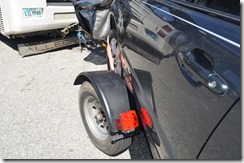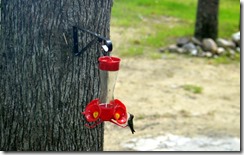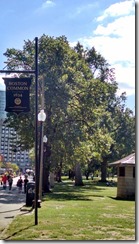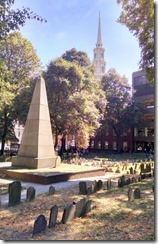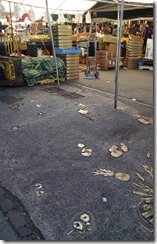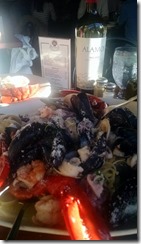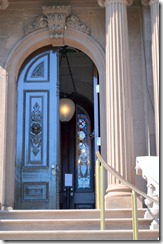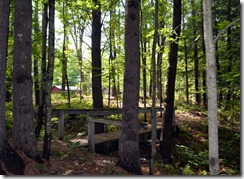Our next free time escape took us to visit John’s sister and brother-in-law, niece and nephew, all living in Holden Massachusetts. Taking LilyPad and boon-docking, using our generator/water tanks and living in the parking lot of the Auburn Elks Lodge was an economical way to visit but not one I wish repeat. I enjoy boon-docking but much prefer a quiet scenic park-like area to a blacktop parking lot next to an Elks Lodge bar.
The Never Ending Story of “It’s always something” hit hard this week, beginning the series of unwelcome events as we prepared to exit our campsite at the onset of our Holden journey. We read stories of far worse things happening to others but it is disheartening when our list goes on without end. Exiting, I drove the car, John drove the motorhome. Being easier to hook up the car in the campground on the downstairs level, two-way radios in hand, off we drove. Turning to notice John driving away with the door awning still extended I spoke into the radio warning him to stop. As John rolled closer to the huge tree branch, the awning positioning itself for imminent destruction, I panicked and sprinted after the motor home, banging on its rear end. John stopped with the awning a smidge short of hitting the limb. I cringed at the thought of the cost to replace a ripped off awning. When he stopped and I opened the door, he said he didn’t hear me on the radio. Well Duh…hard to hear when his radio was off. Awning out, phone off, two “Oops” and we hadn’t even left the campground.
Hooking up the car, John drove off in a cloud of dust. Luckily he noticed the wildly waving arms of a camper running behind us. John had set the parking brake on the car and was dragging the locked wheels along the road. Three “Oops” and we were off.
A few days later, on our way home from Holden, we stopped for gas. After filling up, we started to exit the pumps and I heard a loud “thunk” that shook the motor home. John kept moving but I yelled “don’t move” and rushed out the door to inspect the RV and car. Our newly purchased, but old and decrepit car tow dolly had twisted, not something it should do, and shoved one of the steel tire ramps into the underside of Ribitts driver’s side door.
Securely wedged, the only way to move the wheels of the dolly was to lift the car up and off. Luckily we were able to disconnect the dolly from LilyPad, leaving only the car and dolly stuck in the middle of the gas station parking area. “Oops” number four and counting.
In 44 years of marriage, we have not been without AAA. Owning a motor home and car required us to regretfully change companies. Coach Net specialized in car and motor home insurance and we gratefully pay Coach Net to rescue us anywhere in the United States and Canada. It was difficult explaining exactly what had happened for Coach Net to know what to send to the rescue. Telling them we needed to lift the car off the tow dolly brought a long pause, then a barrage of questions. To their credit, within 20 minutes, they sent the perfect size tow truck and an experienced driver.
The gas station was next to an auto body shop and the owner agreed to heat and bend the tow dolly frame back into its proper position, solving any future problems once the car was freed.
This is where I tell John, “I told you so”. When we first picked up the tow dolly, I mentioned it was extremely old, needed work, looked bowed in the middle and I wouldn’t use my dollars to make the purchase. John talked with the seller, thought it looked fine, took the owners claim that the tires were fine and trustingly handed a complete stranger the cash.
Back to our site with LilyPad minus the tow dolly, parked but not settled, John partially slid out our kitchen slide to hook up our WiFi cable. He left a large flashlight on the slide rail and continued to let out the slide. I heard a cracking sound and yelled “wait”, Noticing the flashlight beam of light atop the slide, I pulled it out. Another “Oops”. This seasons last few “It’s always something’s” have stressed out my last nerve.
Settling back in at the campground, the other workamper caught me up on the latest scandalous roguery of our chaotic, homeless tent families. She had suffered the wrath, foul mouth and explosive temperament of one camper after being asked to encourage them to load up their multiple bags of smelly leaking trash on the campground truck and drive it up to the dumpster. The camper screamed and threw insults at her about us workampers being the “establishment” and we had no business telling him to clean up his campsite.
We presently have five homeless families, four with children. I have nothing against people down on their luck, however, being financially challenged is no excuse for leaving rotten food, empty bottles, cans and piles of dirty clothes strewn across tables and the ground. The rest of the campers manage to deposit their waste in the lined trashcans, which the owner supplies, disposing full bags in the dumpsters instead of leaving them piled around their campsite. And in a family campground, it is inexcusable to be screaming obscenities at your young children, excessively drinking all night and shirking the responsibility of watching your own offspring. No other guests initiated an “in your face” high volume disrespectful confrontation with John, then me, over who’s responsibility it was to watch their child. The child was standing shoulder deep in the river, without a lifejacket, unable to swim, wailing and well within earshot of a parent who chose not to react. It had the appearance of a law suit waiting to happen. For a handful of days previous, we listened to him preach unflattering claims of our shortcomings to his fellow homeless neighbors from the steps of the men’s bathroom. I listened to him rant and rave as I scrubbed the women’s bathroom. I don’t do “bite your tongue” exceptionally well but dealing with power keg personalities is best left to professionals.
Short of a few squirrels, one porcupine, a dozen or so wild turkeys and a few deer, not many interesting wild things have crossed our path. Leaving the gallon size hummingbird feeder out while we were visiting family in Holden, expecting to eventually draw hummers to our site, no liquid was missing upon return. Down it came, replaced with a smaller version. Again, no hummers. The feeder hung full for another three days and I considered giving it up for the season. The next morning, as I stood inside by the front door, a medium sized hummer was paused with its beak fully engaged in the yellow fake plastic flower, draining as much sugar water as he dared before spying me and speeding off. Next day we saw him twice and he continued drinking daily until the last week of our stay.
This morning, before we began our chores, John overfilled the fresh water tank and our site got a thorough drenching. Although I consider this another “Oops”, there was a silver lining. It wasn’t the black tank.
End of another day, work complete for another rotation, we readied ourselves for tomorrows visit to one of my favorite small towns, Salem, Massachusetts. KatieBug would have a sleep over at Yellow Dogs Inn so we could relax the entire day and not have to rush home.
Salem’s hokeyness begins shortly after exiting your parked car. We spied a Little Shop of Horrors plant plopped out in front of a building, encouraging tourist to enter.
We sat outside the Visitors Center waiting for Seth, our tour guide for our Groupon tour purchase. After joining up with another couple, Seth led us strolling through town enjoying tidbits of information along the way. Because we have toured Salem before, we noticed each tour guide shares the tales with slightly adjusted facts, personalizing each tour. The one fact that is never revised or altered is the one exposing the details of the Salem Witch Trials.
Salem Massachusetts is a must-see for anyone visiting New England. Not for the corny backroom séances or the satanic influence enticingly glaring out at tourists from dark back-alley shops but for its amazingly resilient seacoast townspeople, early American history and from its humble beginnings, what it is best known for worldwide, the Salem Witch Trials.
Although the granite surround in a park like setting is designed to be a place of respect and reflection, I found the memorial littered with pieces of trash and cigarette butts. Brushing trash away with my shoe, I took a picture of the victims’ protests of innocence, carved in granite, lying across the entrance. Their cries of anguish haunted my thoughts as I stood next to the monument. Twenty people, falsely accused, tortured and sent to their deaths.
Shading the stone memorial are five Locust trees. Locust trees are the last to flower and the first to lose their leaves and were planted to represent the injustice of the trials. You can see tombstones in the background, a reminder of those who stood by in silence as they witnessed the hysteria.
The memorial park is dedicated to the enduring lessons of human rights and tolerance learned from the Salem Witch Trials of 1692. It was dedicated on the day of my birth, September 9th. Although John suggested it, this in no way connects me to the occult. Witch Doctor, yes…Witch, no.
Three hundred and twenty four years later, society’s indifference to oppression is as callous today as it was during the horrific Salem Witch Trials of 1692. Sadly, we haven’t attained greater tolerance or gained further wisdom from past actions as some would wish us to believe.
We walked by St. Peter’s Episcopal Church and hesitated long enough to learn about those buried on church grounds. The exact number is unknown as graves were moved to provide space for development in 1845. Some of the tombstones were incorporated into the chapel walls and headstones were stored haphazardly in the church basement during expansions. It is not known if the headstones represent the human remains beneath.
The historic Lyceum building, now Turner’s Seafood, is built on top of the former site of Bridget Bishop’s apple orchard. The building is reportedly haunted by the ghost of Bridget Bishop, the first victim of the Salem Witch Trials. The historic building has been featured on many paranormal shows including Ghost Adventures and Ghost Hunters, as were many other of the centuries old buildings in Salem. It is said that the smell of apples wafts through the building. Poking my head inside, no scent of apples, only the scent of French fries.
Our previous to The Burying Point was at night, when the grounds were closed and no entrance was allowed. This time, our visit was in daylight and we were able to walk around the grounds.
Seth pointed out Col. John Hathorne Esquire’s grave marker. Often portrayed as a judge in the Salem witch trials, he was an executor and the only one who never repented of his actions. You may notice that his famous son, the writer Nathaniel Hawthorne, spelled his name differently. The name was so scandalized by the actions of his father, he changed the spelling to distance himself.
The most photographed and notable statue in Salem is of Roger Conant, the first settler in 1626. His home is available to tour and is located a block from the statue.
In 1830, the house at 128 Essex Street, one of the grandest in Salem, was the scene of a brutal murder, a twisted tail of greed and deceit that sealed the fate of the owner, 82 year old Capt. Joseph White. White was a wealthy but childless widower who made his fortune as a shipmaster and slave trader.
The murder captivated the nation and inspired the writings of Edgar Allan Poe and Nathaniel Hawthorne. Congressman Daniel Webster, the famed lawyer and congressman, was prosecutor at the trial. Webster’s summation for the jury was thought to have been the inspiration for Poe’s “The Tell-Tale Heart,” and may have affected the mindset of Nathaniel Hawthorne’s writings of family fortunes, abounding guilt and retaliation. Smithsonian Magazine’s website has substantial details of the famous murder.

On the corner, across from the historic Hawthorne Hotel, stands StickWork 2016, the artistic endeavor of artist Patrick Dougherty with contributing efforts from the Salem community. I Googled his work. Impressively massive forms from natural sources.
Our tour now ended, we strolled once more through the streets of downtown Salem before daylight faded, climbed into the car and drove the coastal route back to Lee. Dinner was yummy Beach Plum lobster rolls. We spent an hour with the TV before bedtime.
KatieBug greeted us happily as we picked her up the next morning from Yellow Dogs Inn. Back to LilyPad, starting the first of several loads of laundry, a quick trip to pick up groceries, more laundry, vacuuming floors, storing anything not in its rightful space, darkness overcame the campground and another day ended.
Our work week was relaxed now that season’s end was approaching. Just one more major chore, closing down the campground, still loomed ahead. With Boston still on our To Do List, next day off we would schedule KatieBug for another overnight and spend the entire day walking the streets of Boston. I began a mental list of what was most important to see as one day in Boston is never enough time.
Early morning, after our work week ended, we dropped KatieBug at the Inn, stopped at Hampton Beach in New Hampshire for breakfast at a small beachside diner then drove to Oak Grove subway station, catching the “T” to Boylston Street. This time we would walk the entire day, no Hop-on/Hop-off bus or subways other than the one back to where our car was parked.
Our walk began alongside the two major Boston parks to the downtown library, a short pause on the church lawn to explore the farmers market offerings and to score some delicious goat cheese, then over to Newbury Street.
A U-turn down Newbury Street all the way to the Public Gardens, a shaded comfortable bench on which to relax before stopping to view tourists enjoying the Swan Boats.
We continued our walk through the Commons, stopping to rest at the Frog Pond. In the winter, the frozen pond is crowded with ice skaters and it’s delightful to watch all the agile activity.
Next rest stop was under shade trees near Brewer fountain. My memories of this large open area are filled with the voices of political and religious soap box speeches so often enjoyed on my lunch hour. Open air debate, very invigorating.
Next on my mental list was to stroll through The Old Granary Burial Ground to visit Mother Gooses grave.
When we first lived in Boston, rubbing pencil lead over a paper placed over the marker design, also known as grave rubbings, was allowed. Sometime after we moved, it was made illegal and the city closed the grave yards at night to keep the stones from being damaged. When viewed up close, the carvers work is beautiful and detailed.
You cannot visit the Old Granary Burial Ground without paying tribute to all the founding fathers along the cemetery path. The Franklin Family Monument is clearly visible from any of the paths.
Robert Treat Paine (1731–1814), signer of the United States Declaration of Independence.
Samuel Adams (1722 – 1803), an American statesman, political philosopher, and one of the Founding Fathers of the United States.
Paul Revere (1735 – 1818), was an American silversmith, engraver, early industrialist, and a Patriot in the American Revolution.
Founded in 1660, the Old Granary Burial Ground in Massachusetts is Boston’s third-oldest cemetery and one of the major stops for colonial dressed guided walking tours.
John and I moseyed back through town, a pause in front of Franklin’s birthplace,
crossing in back of the Old State House, the site of the Boston Massacre,
down to Faneuil Hall, topped with Boston’s most famous weathervane, The Grasshopper, from acclaimed craftsman Shem Drowne who crafted the weathervane atop Old North Church.
Across the street sits the Haymarket, an enjoyable viewing of the city’s weekend fresh garden offerings.
If you focus your attention downward while walking Haymarket streets, you will view the city’s 1976 artistic creation of bronzed trash and debris providing an intimate experience of the market, open or closed. The “trash” is embedded in the crosswalks and is enjoyed by visitors during the market and after all has been power washed away.
A short jaunt across the freeway is The North End, the Italian section of Boston. I loved this area while living in Boston and my adoration has not lessoned. Part of the Freedom Trail, the red bricks pave a path to the colonial home of American patriot Paul Revere. The red line passes the Old North Church, the oldest standing church building in Boston and “one if by land, two if by sea” fame. Paul Revere’s statue dominates the park behind the church.
Our dinner choice for tonight was Giacomo’s Italian Restaurant, a tiny hole in the wall restaurant down the street from Paul Revere’s statue in the North End.
Open at 4:00 pm daily, John waited in line until the doors unlocked. Not the first to enter, our seats were in the front window, without shade and overly warm. The atmosphere was noisy, casual and homey. The food was excellent. We ordered the special, never believing we would finish the gigantic plateful.
After our delectable dinner, the plan was to walk back to Faneuil Hall Marketplace. Stuffed as we were, my darn sweet tooth saw Mike’s Pastries, the premier Italian bakery in the North End, and started wailing something fierce. I knew it wouldn’t stop until it got a double shot of something sweet. By the sound of the racket in my head, I’m thinking I may have several sweet teeth back there in my jaw. Finishing one of Mikes exquisite double chocolate peanut butter brownie quieted down the chores.
Waddling down the streets of the North End, across Faneuil Hall, descending the stairs into the subway and back to the car. We were the only ones in the subway car for most of the ride. An hour after exiting the “T”, we arrived at LilyPad. Early to bed, early to rise to pick up KatieBug and relax one more day before the start of our last week of work.
Our return visit to Portland Maine was a quick half day trip taken our last free day before work. Purchasing Groupon tickets to reduce the cost of entrance fees, our primary afternoon destination for the day was The Victorian Mansion. The mansion is an Italian villa style home decorated by Gustave Herter, one of America’s first interior designers. No pictures are allowed inside so I borrowed one from the internet showing the detailed wall paintings.
The house and furnishings are historically accurate and exceptionally well preserved, offering a peek into the “Gone With the Wind” pre-civil war opulence. The building is distinguished for its architecture and incredible hand painted original interior walls, custom carved Italian marble fireplaces and hand carved interior woodwork.
In awe as I approached the immense carved front doors, stepping through to an additional set of interior doors with intricately decorated etched glass panels, the feeling stayed with me throughout our tour and lasted beyond exiting down the back steps.
After the tour, lunch, a walk around town and back to Lee for a good night’s rest before morning arrives and we begin putting the campground to sleep for the winter.
Today begins our last few days of workamping as we start closing duties. Plants in baskets are tumped over (a Texas term meaning spilling out the contents of a container) bottoms up, pressed into the earth, crushing the flowers into the soil, the winter snows packing them into the ground and turning the decayed flowers into next spring’s fertile soil.
The 4 pounds of extra corn, left over from the forty, 7 inch square, Corn Hole Toss bags I sewed last week for the owner, has been scattered in the front field for the deer and turkey to carbo load up for the winter.
Picnic tables are moved close enough to a tree to be upended and leaned over so snow doesn’t pile up on top. It was a bit less complicated than tipping cows because you don’t have to sneak up on them.
The beach is cleaned, chairs gathered, stacked and moved into the rec center via the campground truck.
Boats emptied of paddles and stacked on the boat rack.
Garbage cans are emptied and moved inside the front porch of the original owners cabin down at the river’s edge.
Seasonal families are packing up and closing down their sites. Blue tarps cover all odds and ends gathered together and wrapped over the tops. Grills and trailers also covered. A few abandoned broken pieces of metal sit in wait for the metal guy to come fetch them.
Next morning, breakfast at Tiltin’ Diner, a 50’s style diner and part of the Common Man chain of restaurants in New Hampshire, heartily enjoyed with our forever buddies since pre-children days, Rich and Judi.
This year we were able to visit them several times, reminiscing about the old days, sharing news, not thinking about how many years have gone by as we watched the sun set on peaceful Sawyer Lake from their porch.
Next years workamper sites will be next to the rec center, a few yards from our current site.
They are open, large, flat and together in one area.
Later in the day, after closing duties were complete, we shared a few bottles of wine and said our farewells to Pat, Chris, Doug, Scott, Susan and Conchita (Pat’s fur baby) before we settled down for our final night at Wellington Camping Park and made ready for our journey home via Canada. Yea, I know it’s not the shortest route, but what good is retirement if you can’t take the long way home and stop to smell a few roses?
Five months ago, I swore I heard the theme song from Deliverance playing somewhere in the distance as we bumped down the dusty dirt incline to our site. My first impression was extreme discomfort and I was looking for any excuse to be elsewhere. The campground presented dozens of valid reasons why we should leave and it appeared to be another unfortunate choice.
Two months into our workamping job, our move upstairs and away from the dust calmed my “get me out-of-here” pleas and changed them to “we’ll stay for the term”. Seeing Pat and the family work diligently to improve the campground, my opinion changed once more. As we helped Pat prepare to close the campground for the season, I admit, I have become increasingly fond of the owner, her Golden-doodle fur baby, her sons and family. They will be missed.

